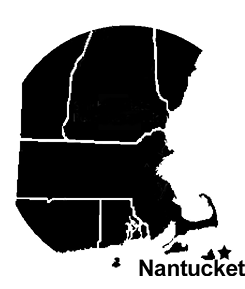 Nantucket—my home birding patch—is the name of the county, the island, and the town—which comprises all of the island’s villages and hamlets. The two offshore islands of Tuckernuck and Muskeget also fall under the jurisdiction of Nantucket.
Nantucket—my home birding patch—is the name of the county, the island, and the town—which comprises all of the island’s villages and hamlets. The two offshore islands of Tuckernuck and Muskeget also fall under the jurisdiction of Nantucket.
The Steamship Authority, the island’s main lifeline to the rest of the world, provides ferry service to Nantucket. In 2021, a round-trip ticket between Woods Hole and Nantucket Island costs $19.00 for adults and $10.00 for children 5–12. Between Hyannis and Nantucket, the fare is $39.00 per adult and $20.00 per child. If you are looking to cover Nantucket on a budget— whether you are trying to pick up Barn Owl for your state list or chasing some far-blown vagrant—taking your bike is definitely the way to go. You can stow your bike for $8.00 from Woods Hole and $14.00 from Hyannis. In-season round-trip rates for automobiles are $192–$250 from Woods Hole and $492–$600 from Hyannis; reservations fill early, and standby is not guaranteed. Off-season rates are lower, and bringing a car is less of a hassle. Nantucket via bike is an appealing mode of transportation and gives you the ability to explore more of the island. Birding on foot is another option. Nantucket is at its best when enjoyed at a leisurely pace with the wind at your back. This mentality is best reflected in some of the bumper stickers you are bound to see, such as “20 is plenty in ‘Sconset” and “What’s the rush? You’re already on Nantucket.”
“East or west?” is a question familiar to every Nantucket birder. To the west is the tiny seaport of Madaket, with the associated neighborhoods of Dionis, Fisher’s Landing, and Jackson Point. To the east, one finds the historic beachfront hamlet of Siasconset or ‘Sconset—few locals actually refer to this place by its full name—and the villages of Wauwinet, Quidnet, and Tom Nevers. My answer is unwaveringly “east.”
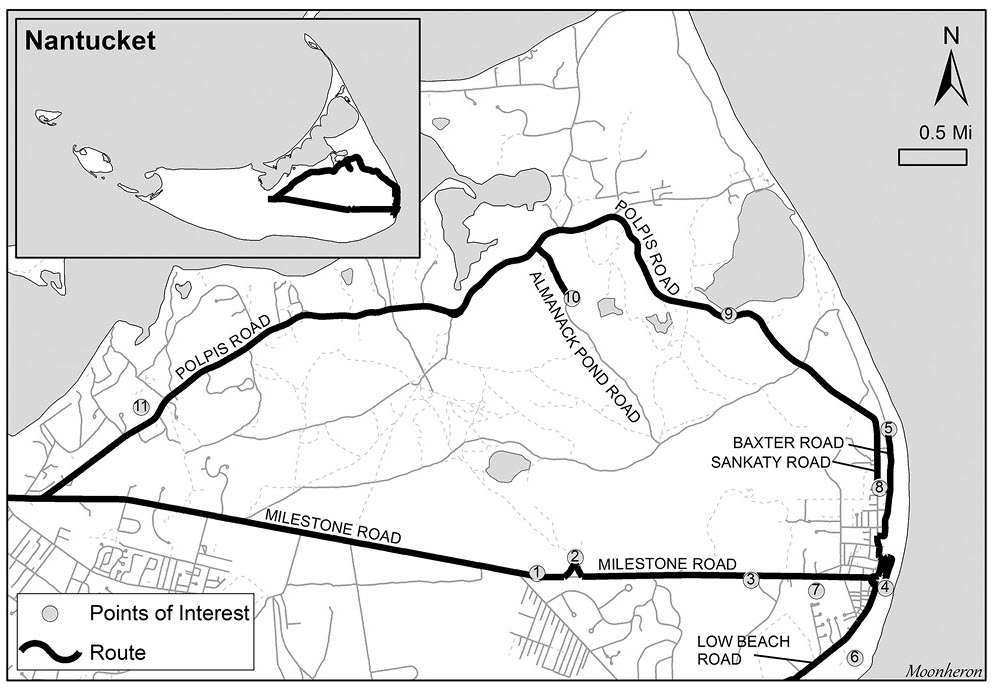
Map of Eastern Nantucket.
Heading west is a promising endeavor as well, and hitting it right during spring or fall can reap a terrific morning flight over Millie’s Bridge or a plethora of migrants working their way through the pine expanses. With Madaket and Jackson Point in the west, birding is intuitive; everywhere you want to bird is basically within biking or walking distance, and it is easy to cover plenty of ground using a vast network of quaint avenues and side streets. However, there is a certain cachet that is lost when going that route.
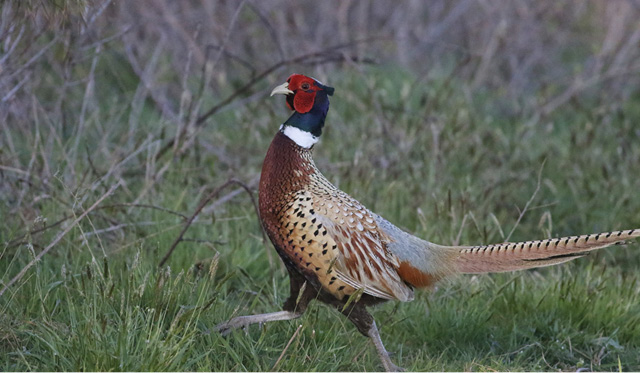
Ring-necked Pheasant is an uncommon and local breeding species deep within the eastern moors, although the cock’s rooster-calls can be heard early mornings from places like Altar Rock or Folger’s Hill. All photographs by the author unless otherwise indicated.
On the east side of the island—in stark contrast to the compact layout of the west— the places for “good” birding are spread out over a much larger area. In the realm of the under-birded destination of Nantucket, the east is the road less traveled. This is not due to a lack of avian biodiversity, which is consistent throughout the island, but due to a lack of knowing how to bird the east end thoroughly. In this article, I discuss how and where to bird the east side of Nantucket. I recommend a personal vehicle, but it is not a must; many visitors take the bus that leaves from town and drops them off in the middle of ‘Sconset village. Unfortunately, this is a seasonal prospect; the Nantucket Regional Transit Authority has scheduled the route between June 14 and September 6 in 2021. The bus runs every hour on the quarter hour, beginning at 7:45 am. The charge is a modest $3.00 fare each way and includes the option of bringing a bike with you.
Heading east from town is as simple as knowing which direction the beach is. Before embarking down Milestone Road, consider stopping at either the Stop & Shop or Cumberland Farms on Sparks Avenue to load up on food; this will be the last reasonably priced food for miles. Restrooms, water, and the sweet smell of salt air are the only things you will find free to enjoy on this end of the island, so take advantage of all the facilities that mid-island has to offer before you get started. Indeed, the only public toilets in ‘Sconset are located at the corner of Shell Street and New Street at Pump Square.
Once you pass the rotary on Milestone Road, you begin the six-mile trek toward Siasconset. On either side, you will see miles upon miles of pitch pine that has invaded the grasslands and heathlands, recalling Outer Cape Cod more than Nantucket. Some of these pine stands will be opportune spots for owling in the winter months, so any of the dirt roads off Milestone Road are worth checking. If you are on this road in the spring, keep one eye on the road and one eye to the sky for Swallow-tailed Kites. On your way back, whether in spring or late summer, look for Common Nighthawks overhead.
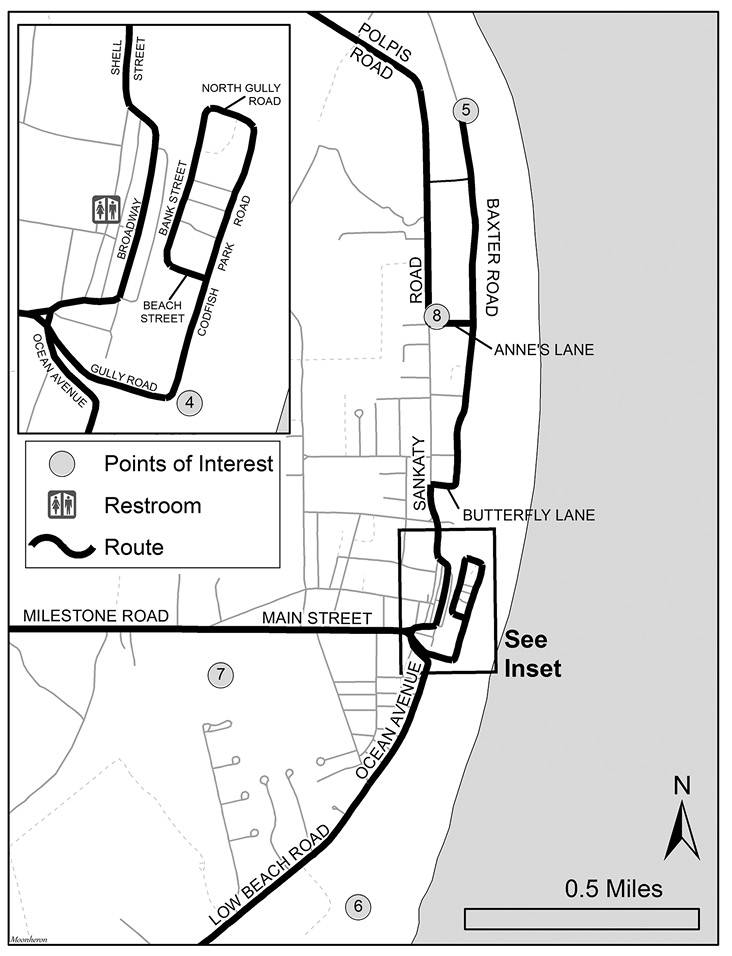
Map of Sconset
The first stop along Milestone Road is the Milestone Overlook (1) just about 4.0 miles from the rotary and 0.25 mile before the must-see Milestone Cranberry Bog (2). As soon as you pass the turnoff for Tom Nevers on the right, there will be a pullout on your left that overlooks the entire bog complex. It can be quite good for skywatching and is a fine place to scan the bogs with a scope. I like to try to get a read on water levels from here in order to select the fields around the bogs that look like they could hold the most ducks or shorebirds, depending on the season. If you visit the island in summer, venture west from here on foot into the appropriately named Nantucket Serengeti, which can host nesting Merlin and Ring-necked Pheasant. One of my favorite memories from here is flushing a whole family of pheasants— a mother and a few of her chicks—from along the path.
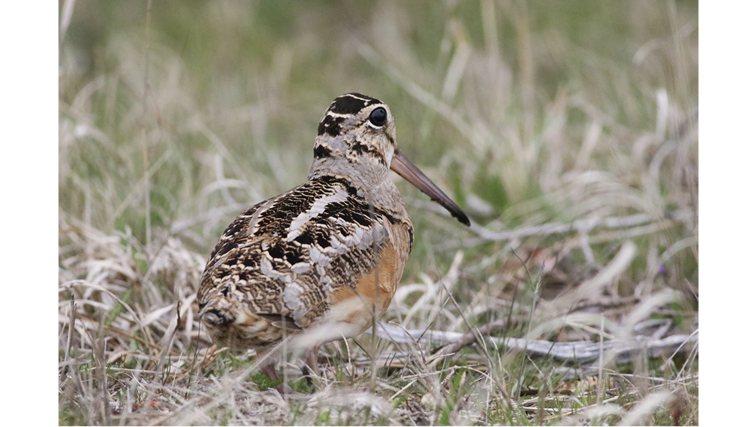
American Woodcock breeds almost exclusively on the east end of the island, with the farm fields of Polpis and the moorlands being particularly good spots for hearing this bird’s haunting display noises.
Once you have had your fill of the vast, rolling Nantucket landscape, drive east 0.25 mile to Milestone Cranberry Bog —until 1964 the oldest and largest contiguous cranberry bog in the world, now a collection of separate bogs—owned and operated by the Nantucket Conservation Foundation. At the brown rock with the number 220 on it, turn left onto the dirt road that leads you through red gates. These gates will occasionally be closed in early spring for pesticide spraying (I can never remember the exact dates, but they seem to coincide with peak Pectoral Sandpiper season) and in fall for harvesting. Continue to a quaint little parking lot and a few trails that branch off in different directions. Take the trail that heads north until you reach a modest-sized compost heap, which has been known to hold Indigo Bunting, as well as several species of sparrows. From this spot, you will be able to see all of the bogs so you can plan your route. I like to make my way east first and circle back because I usually come here in the afternoon, and I want to avoid looking at the birds when they are backlit. More often than not, I bring a scope. Unless you plan on scrutinizing every mallard to check for Mottled Duck as I sometimes do, there is no need for one. The impoundments are sufficiently close together that you can cover each field by walking the perimeter. If you go through the fields, perhaps for a snipe hunt, make sure you are wearing your most durable pair of knee-high waterproof boots.
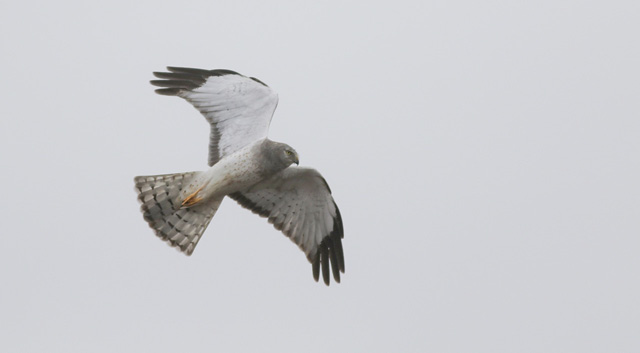
Northern Harrier is a quintessential bird of the sandplain grasslands of Nantucket, an endangered habitat, 90% of which can be found on Cape Cod and the islands.
My absolute favorite time of year to bird Nantucket is in late August. The weather is perfect, there is ample time for exploring, and by that time fall migration is well underway. Coming to the Milestone Cranberry Bog during this time is an experience I recommend to anyone, anywhere. There are many species of goldenrod that are in bloom—too many for me to identify—and often in the twilight the serenade of mole crickets emanates from the sides of the impoundments. Bobolinks begin descending en masse around this time, and waders of all sorts can be found here, too. Little Blue Heron is a frequent early disperser, and some begin to arrive as early as July. Great Egret and Snowy Egret also may be readily seen here.
Before this area was cultivated into commercial cranberry bogs in the nineteenth and twentieth centuries, these fertile moors were prime hunting grounds during fall migration for Eskimo Curlew, American Golden-Plover, and other shorebirds that would be blown in from offshore following northeast winds. Now, although the former species is critically endangered and the latter is uncommon, these fields still yield good numbers of wind birds—perhaps the best on island that are not along the immediate coast. Stilt Sandpiper, Least Sandpiper, Solitary Sandpiper, as well as Greater and Lesser yellowlegs all can be found at Milestone Bog in late summer and early fall. The occasional oversummering waterfowl may come as a surprise to those who are unfamiliar with the reputation of southeastern Massachusetts for retaining these birds. Northern Pintail, Green-winged Teal, and Hooded Merganser have been recorded here during June through August. Although you can thoroughly cover the entire bog complex in under two hours, it is easy to stay well past sunset. I often stay on still summer nights to listen for Sora or breeding rails.
Return to Milestone Road and continue east for another 1.25 miles. Overgrown farm fields dominated by scrub oak replace the stands of pine trees. There is a small patch of wetland to the south of Milestone Road, directly across from the Siasconset Golf Course parking lot (3). Although this parking lot is private, it is okay to idle on the side of the road and pace back and forth along the bike path. This is one of the most reliable spots on island in February and March for American Woodcock, but unfortunately, witnessing their flattened remains along the median strip is not uncommon.
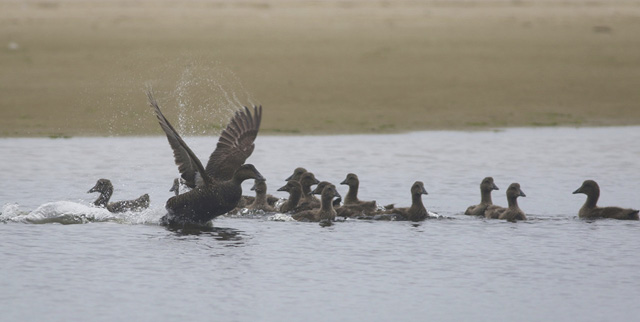
Nantucket’s outer islands are touted to be some of the southernmost breeding sites of Common Eider in the Atlantic, and it is possible to see family groups like this that have just dispersed from their nesting grounds.
This wetland is unusually productive in spring for warblers and Empidonax flycatchers, even though Nantucket is one of the least diverse places in New England for neotropical migrants in spring. Although we are ideally situated in fall for collecting hundreds of thousands of these trans-Atlantic visitors, the situation is rather bleak in spring because we are quite far out of the way for a bird whose primary trajectory is a slingshot back to the same plot of forest in southern Quebec that it nested in the previous year.
Check across the street for geese or Sandhill Crane that might be lingering on the golf course. In winter 2017 there were two Ross’s Geese here for an extended stay, appearing just in time for the Christmas Bird Count (CBC). Snow Goose has also been recorded at this spot in every month from December through May.
The next stop is Siasconset, better known as ‘Sconset. The best birding in this tiny tourist village usually takes place in fall and in winter. Among the eight sectors of the island, ‘Sconset often ranks high for total species during the CBC. Alas, in recent years an increase in development has eliminated some of our favorite birding stops here, but a lot of the good ones remain.
First and foremost is Codfish Park (4), which is not a traditional park, but rather a small collection of houses just below the bluff. To get here, follow Milestone Road from the wetland for 0.8 mile until you reach the Main Street Rotary. Take the first right off the rotary onto Ocean Avenue, then immediately—in 40 feet— take a slight left onto Gully Road, a narrow two-way street. Follow Gully Road—going under the ‘Sconset Foot Bridge—for approximately 500 feet to the parking area for Codfish Park beach. If you park in front of the pitch pines, you may sometimes find a decent-sized mixed flock without moving far from your car. In spring, Summer Tanager has been seen here along with a number of Baltimore Orioles, Pine Warblers, and Hairy Woodpeckers (still somewhat of a rarity on Nantucket).
During the winter, the sea watching from this spot can be excellent at first light. Codfish Park traditionally has been a spot to see tremendous numbers of gulls, including Little, Black-headed, Bonaparte’s, and Lesser Black-backed—along with every Iceland Gull on the continuum from the white-winged L. g. glaucoides to the Herring Gull-like L. g. thayeri. Gull numbers peak sometime in late February to early March and last only a week at most. By mid-March and April, most have either gone to Quidnet or moved inland.
Continue along Gully Road as it curves parallel to the beach; it becomes Codfish Park Road at Beach Street. Follow Codfish Park Road to the end and curve left onto North Gully Road. In approximately 1,200 feet you will reach the intersection of North Gully Road and Bank Street. Yellow-breasted Chat was almost a guarantee here on any given CBC, but in 2019, a private developer tore up all of the thickets, and now only a bare plot remains. Beyond this plot is another large stand of pines that is slightly more productive than the pines at the previous stop. In fall, large numbers of migrants descend on these trees; counts of up to fifty Blackpoll Warblers have been tallied. The edge of the bluff supplies some meager undergrowth habitat, and given the right day, you may find warblers, orioles, and tanagers clinging to the sides of this cliff face on any bit of vegetation they can find. You can go back via Codfish Park Road, but consider returning by way of Bank Street. Amazingly, a homeowner along this street has had Black-chinned Hummingbird come to his feeders not once, but twice—first in November 2007, second in November 2010.
When you get back to the Main Street Rotary you have two options: continue north to the ‘Sconset Erosion Viewpoint (5) for sea watching, or head south along Ocean Avenue for 0.8 mile to Low Beach (6). Both locations have held their fair share of rarities. The good news is, you can bird both spots, but if you have time for only one of these stops, here are some things to consider.
To get to the viewpoint, exit the rotary onto Main Street, then turn left onto Broadway—which turns into Shell Street—turn right onto Butterfly Lane, turn left onto Baxter Road, and drive approximately 0.9 mile. ‘Sconset Erosion Viewpoint offers considerable elevation, and you are bound to rack up a high species total. However, many of the birds are quite far from the shore, and a scope is a necessity. The birds tend to be sedentary here, rather than on the move, so they are easy to observe. If you have a scope and enjoy the challenge of squinting at far-out eider flocks, then the Viewpoint is right for you.
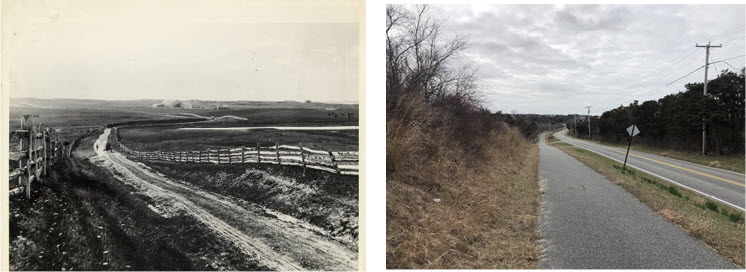
A view of Folger’s Marsh from the top of Polpis Road in 1890 vs. 2020: on the right of this picture is where the University of Massachusett’s biological field station now lies. The differences show the changes in vegetation that have occurred, most dramatically within the last half-century. Left photograph courtesy of the Nantucket Historical Association.
It is also my experience that birding at sunrise is much more manageable at the Sconset Erosion Viewpoint than at Low Beach, where you will probably find yourself looking into the sun for a solid hour. However, if backlit morning flights are not your thing, there are plenty of beaches along the south shore to cover, which some island birders swear by.
Low Beach is 0.9 mile from the rotary via Oceanview Drive. It is the southeasternmost beach on Nantucket. As the name implies, there is little to no elevation here, and what you can see is basically right in front of you. Many of the birds here are close to shore, but they are also on the move, rarely staying long enough in the rip to feed. If you don’t have a scope, Low Beach is the better option for optimal viewing.
The area by Low Beach is also home to a now semi-defunct sewer bed, which attracted Sage Thrasher, Cliff Swallow, and Lapland Longspur in the past. The new ‘Sconset Water Tower (7) rises up west of this spot, and it is from this side of the tower that the pair of nesting Common Ravens is most easily viewed. Prior to 2019, Nantucket County possessed only a single confirmed raven record. Since then, this species has successfully nested along the back of the Water Tower in 2020 and looks to be on the same track again for 2021.
Before leaving Siasconset, be sure to check Anne’s Lane (8) and the adjacent “trifecta thicket” for seasonal rarities. If you are returning from the viewpoint, drive south on Baxter Road, and just shy of 0.5 mile, take your second right onto Anne’s Lane. From Low Beach, return to the rotary, take the second right onto Main Street, then turn left onto Broadway—which turns into Shell Street and then into Sankaty Road—for 0.5 mile, and turn right onto Anne’s Lane. In spring, Anne’s Lane comes alive with cherry blossoms that attract orioles, tanagers, and warblers. Indigo Bunting and blackbirds are also drawn to the nearby feeders. The “trifecta thicket” is named for a Bay-breasted Warbler, an Orange-crowned Warbler, and a Prairie Warbler concurrently found in this tangle at the corner of Anne’s Lane and Sankaty Road on the CBC held on December 27, 2015. There is a piece of cocktail trivia associated with this corner as well; one of the thumbnail images for Bay-breasted Warbler on the Merlin app is of the bird found on the 2015 CBC.
Drive north on Sankaty Road, which turns into Polpis Road where it curves left. In 1.2 miles, you will pass Hoick’s Hollow Road on your right and the entrance to Mass Audubon’s Sesachacha Heathlands Wildlife Sanctuary on your left. Continue for approximately 0.7 mile along a beautiful scenic drive along Sesachacha Pond (pronounced sus-ack-a-cha). Stop at the Sesachacha Pond pullout (9), which has been reinforced in recent years to prevent the road from collapsing into the pond, but a serious nor’easter is bound to wash over the pavement with a few inches of water. In winter, Sesachacha Pond, the largest of Nantucket’s waterbodies, will often hold large numbers of scaup, scoter, Ruddy Duck, and merganser. Indeed, this is arguably the best place to score Common Merganser on the island. The Ruddy Duck count sometimes exceeds two hundred birds. At least one Tufted Duck has been seen here in early winter over the last few years, usually arriving with the first major flocks of Greater Scaup. The pond is also an exceptional spot for Great Cormorant on Nantucket and is likely the only place you will encounter this species outside the jetties of Nantucket Harbor. Sometimes they will perch on the large pine tree across the pond, but more often, they will be at the barrier beach that separates this brackish water from the sea. On a still, moonlit night in late May, listen for Chuck-will’s-widow and Eastern Whip-poor-will; both species may have been nesting here regularly over the last five years.
Continue on Polpis Road for 1.9 miles, turn left onto Almanack Pond Road (10), and bird the road. This can be a choice spot in spring and summer. Northern Parula, Black-and-white Warbler, Great Crested Flycatcher, and American Woodcock breed here. Some of the mainland species are quite at home in this still-maturing deciduous woodland, and rare nesters on Nantucket that are typically more abundant on nearby Cape Cod can be found here as well, such as White-breasted Nuthatch, Red-bellied Woodpecker, and Cooper’s Hawk. Visitors to the Almanack Arts Colony have heard the whiny too-too-too of Northern Saw-whet Owl along the road. If you examine this habitat during the day, it would not seem too far-fetched to think that an Eastern Screech-Owl might reside here as well. This, however, is one of the great mysteries of Nantucket: there are none. Barred Owl and Great Horned Owl are also absent.
Return to Polpis Road and head west for 3.3 miles, where the visage of civilization begins to return as you leave country-style sheep farm estates for modern, affluent suburbia. Moor’s End Farm (11), one of just a handful of commercial farms on the island, is located across from Kelley Road and can be a prime spot to look for gulls in the winter. It is also arguably the best overwintering spot for Palm Warbler in New England, which usually scores this sector at least a dozen on the annual CBC. During the winter of 2017–2018, at least one of the Ross’s Geese spent a few weeks here. Glaucous Gull is reliable at the farm once the scallop pile begins to collect. In the spring, you may see Killdeer in the fields. Access the farm from a parking area at the intersection with Shimmo Pond Road and walk around the fields. However, it is always courteous to let one of the farmhands know; they will appreciate the heads-up.
When you finish birding and arrive back in town, you may want to celebrate your big day with a reasonably priced ice cream cone on Main Street, or a delicious cup of hot cocoa from the Corner Table Cafe at the corner of Broad and Federal Streets. After all, you deserve it.
This is the basic run-down of places to bird on Nantucket’s east end. This is by no means a complete or substantial list, and I encourage you to do your own exploring while out here. There is so much left to be discovered on this island, and there are so few pairs of eyes that are out looking. Consider posting your sightings on eBird and sharing them with the Nantucket Conservation Foundation if you observe anything on one of their many properties. Maybe you could be the one to discover Nantucket County’s first Great Horned Owl.
Skyler Kardell is a second-generation Nantucketer and a rising freshman at Connecticut College in New London. He is the Coastal Steward for the Tuckernuck Land Trust. Skyler is a regular participant on the Nantucket Christmas Bird Count and several local Bird-a-thons.